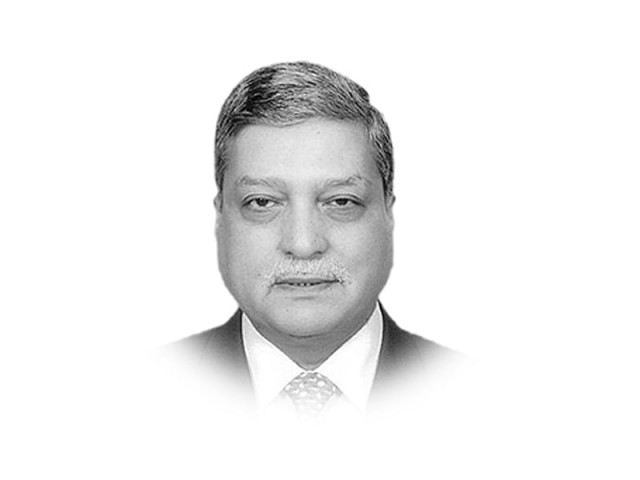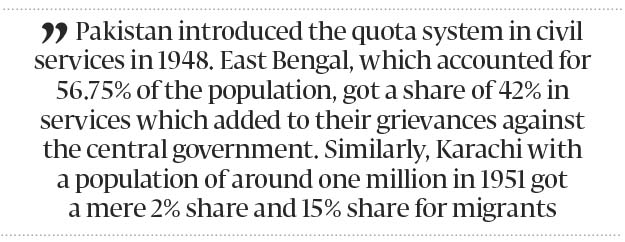Quota system in Pakistan
The federal cabinet at its last meeting directed the establishment division to review the quota system in Pakistan

The writer is a former federal finance secretary and former FPSC member. He can be reached at awrana.rana@gmail.com
Equity and diversity in all state institutions have become a key focus of public policy and politics of federations across the globe. Political scientist Mala Htun (2003) argued that group representation policies are common because they are perceived to advance several of the state’s primary goals. First, the struggle for existence to ensure survival of the state against perceived dangers, including credible threats of civil war or secession, advanced by identity groups. Second, the modicum of justice to safeguard the least advantaged by providing access to positions of authority. Third, preservation of public order identified as an overriding objective of state-building ensured through participation of all identity groups in decision-making. Fourth is the legitimacy that every system of domination needs to cultivate a belief in its own acceptability. These four imperatives — or combination thereof — compel states to guarantee equitable representation to diverse identity groups in administrative and political institutions. Therefore, quotas and reserved seats are not mere democratic accessories but fundamental to statecraft and are thus a form of ‘ethnic corporatism’ offering identity groups legal standing and privileged official access. The quotas and reservation policy in Pakistan is also driven by these imperatives.
As an institution with the pivotal role of advising and carrying out government policies, the civil service is one of such body where the diversity should be found. The dividend in harmony, legitimacy and performance that inclusionary civil services bring was underscored during the 15th Expert Group Meeting of the UN Department of Economic and Social Affairs and the UN Division of Public Economics and Public Administration in May 2000. It was recommended that member states “strengthen the civil service through diversity and mobility, including the dimensions of gender, ethnicity, age and varied populations.” The regional quota system of the Ming Dynasty (1425), US Policy of affirmative action emerging out of the civil rights movement, Employment Equity Act of 1995 in Canada removing barriers for population groups employment, the UK’s Equity and Diversity Strategy of 2008 and race-based reservation of seats in federal civil service in Brazil are all manifestations of accommodating diverse population groups.

China reserves a position for ethnic minorities and women; Sri Lanka has quotas for Christians and Tamils; India introduced reservation for scheduled tribes (7.5%), scheduled castes (15%), other backward classes (27%); Bangladesh reserves posts for merit (45%), freedom fighters (30%), women (10%), tribes (5%) and district basis (10%); and following the Arab Spring, Saudi Arabia has enacted Nitaqat Policy in 2011 requiring the private sector to meet specific employment quotas for Saudi nationals.
Pakistan introduced the quota system in civil services in 1948. East Bengal, which accounted for 56.75% of the population, got a share of 42% in services which added to their grievances against the central government. Similarly, Karachi with a population of around one million in 1951 got a mere 2% share and 15% share for migrants. Punjab was allocated 24% quota against 28% population and all other provinces, including the former princely states got 17% quota against 13.75% population. This quota policy was revised in November 1949 introducing a merit quota of 20%.
The 1956 Constitution extended the quota system of 1949 by 15 years (Article 17) and the 1962 Constitution retained this provision (Article 8) up to 1972. However, General Yahya Khan’s martial law government extended the quota system according to which the rural and urban population in Sindh was given 60% and 40% representation in services on the recommendations of the then martial law administrator of Sindh. The 1973 Constitution merely protected the already prevalent quota system and rationalised it. Not only the shares of Sindh, NWFP (now Khyber-Pakhtunkhwa) and Balochistan were neatly defined but also quota for Northern Areas, Fata and Azad Kashmir were included in the schedule. Karachi’s quota was merged with urban Sindh. The allocation of quota for women and disabled persons in services was introduced during the 1990s.
Empirical evidence, however, establishes that the time has come for abolition of the rural-urban distinction and quota for the two may be considered for merger. Data from the last seven annual competitive examinations for the federal government’s positions show that the ratio of finally qualified candidates from rural Sindh has been better than urban Sindh: 11% of the candidates who appeared in CE-2009 from rural Sindh could finally qualify, 12% in 2010, 11% in 2011, 12% in 2012, 7% in 2013, 9% in 2014 and 11% in 2015. Conversely, only 5% of the candidates could qualify in CE-2009 from urban Sindh; 7% in 2010, 7% in 2011, 5% in 2012, 3% in 2013, 5% in 2014 and 8.4% in 2015.
Secondly, Sindh has the largest unfilled vacancies: 20 out of 25 in 2005; 39 out of 47 in 2006; 39 out of 111 in 2007; 88 out of 99 in 2008; 47 out of 51 in 2009; 57 out of 66 in 2010; 35 out of 45 in 2011; 13 out of 30 in 2012; 37 out of 72 in 2013; 34 out of 82 in 2014; and 31 out of 95 unfilled seats in 2015. The share of urban Sindh out of Sindh’s unfilled vacancies has been 13 seats in 2005; 22 in 2006; 33 in 2007; 42 in 2008; 74% in 2009; 40 in 2010; 24 in 2011; six in 2012; 20 in 2013; 20 in 2014; and 19 in 2015.
We need to recognise that affirmative action policies pursued by successive governments, both military and civilian regimes, and protected under successive charters have been a consequence of the four imperatives highlighted above to bridge the gap between various population groups and regions in terms of their representation in the federal services and decision making. Given the constellation of powers and political axis, affirmative action policies must continue for endurance of the federation and to maintain public order. The provinces are stakeholders and must be meaningfully consulted rather than taking any measures in haste. Or else it can impact the very roots of the federation.
Published in The Express Tribune, November 9th, 2017.
Like Opinion & Editorial on Facebook, follow @ETOpEd on Twitter to receive all updates on all our daily pieces.















COMMENTS
Comments are moderated and generally will be posted if they are on-topic and not abusive.
For more information, please see our Comments FAQ